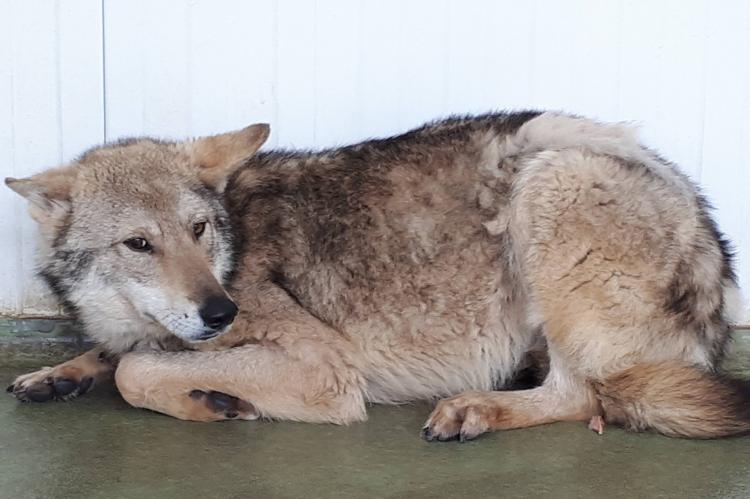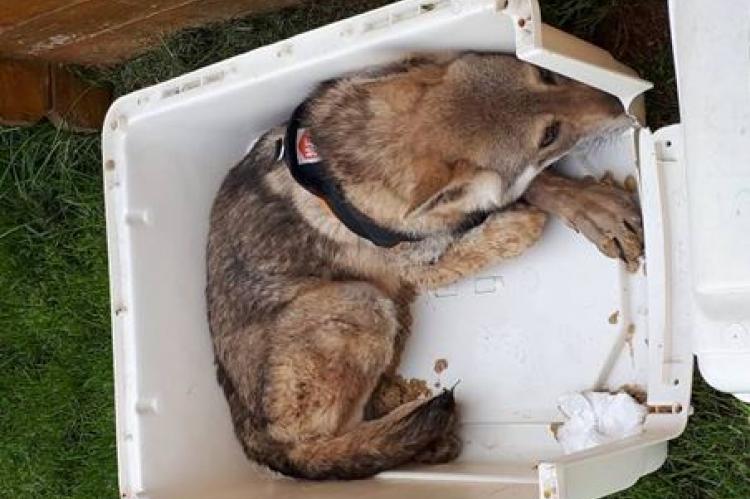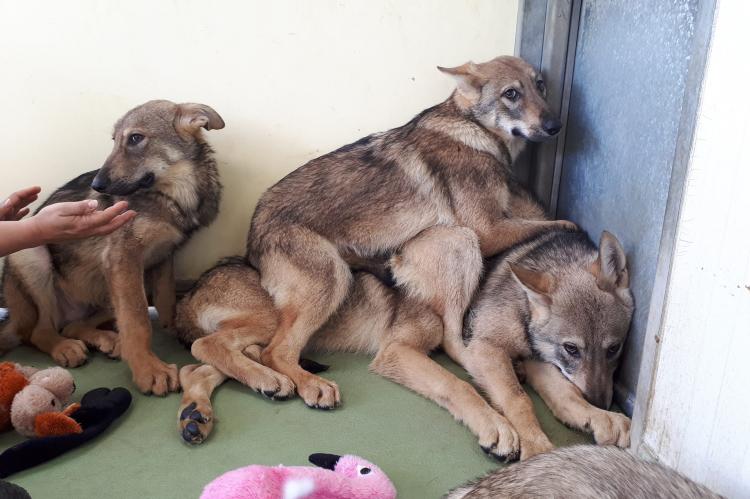The drama of Le Briqueterie
“She is famous in the world of Saarloos wolfhonden and a well known name in the French and European cynology.” (Cornelia is) more than just a breeder, she is an artist who continuously improves the breed with both the eye of a painter and that of an engineer. Her first priority is structure. After that movement. As of yet she is the largest breeder of this breed and produces the most beautiful dogs.”
An enthusiastic description of Corrie Keizer found on the website of kennel Canis Africae, owed by breeder and upcoming judge Nicolas Martin, one of the “students” of Keizer. The website states that Keizer functions as a mentor for this kennel.
And this makes it all so unbelievable that the French judge immediately accepted the statement of the lawyer who said that Keizer did not have knowledge regarding the regulations and only incidentally lived in France as a breeder.
Dogzine received many reactions after a previous article on this breeder of Saarloos- and Czechoslovakian Wolfdogs was published. We will spend the upcoming weeks to look into these reactions and form a complete image of the situation. It has become clear what has happened regarding Le Briqueterie. Even though there are more sides of this story circulating, the Cellule Anti-Trafic confirmed to us that 119 dogs have been taken away. This has been done voluntary and was not a seizure. However, French sources let us know that the event might have been less voluntary than presumed. A legal seizure is something that, also in France, can take a lot of time. Both the gendarmerie and the animal rights organizations agreed that waiting for a legal seizure would not help the situation of the dogs owned by Keizer, which is why they discussed the possibilities of her handing over the dogs voluntary. This made it possible to take away the dogs immediately, a task that took 4 days in total.

The member of the Cellule Anti-trafique who went to visit the place described that the first sight didn’t look as bad. This means that the adult dogs were kept in kennels, even though these were on the smaller side. Pups and young dogs were kept inside the house, which also contained a “maternite”, a place where pups were raised. The basement was used to home young dogs and pregnant bitches. The member described this as “Conditions in which these dogs were kept are unacceptable. The dogs, including pregnant bitches, were kept in an almost completely dark basement. The bitches and their pups were kept in a dark, moist room.”
The dogs, including pregnant bitches, were kept in an almost completely dark basement.
According to the Celulle anti-trafique, the taskforce of France’s SPA, the condition of the dogs they saw was severe, but not too severe. The dogs were underfed and one of them had a large tumor, which she died from several days later. However, the most concerning was the social state of these dogs. They were completely unsocialized, aggressive and/or fearful. Especially the young dogs that were found showed extreme aggression.
Dogzine mentioned earlier that the rehoming of the dogs was going well. However, this was only about the dogs that were brought to the shelter of St. Omer. This is just one of the many shelters where the dogs from this situation were brought to. The dogs who were in worse condition were placed in different shelters and organizations. According to the spokesperson of the Celulle anti-trafique about half of the dogs was rehomed. However, the other half includes dogs that require a lot of time to become social pets. For some of them, this might never be possible. The CAF states that the behavior issues are the biggest problem in this situation. As for the living environment, they have seen worse.
Descriptions of the dogs at the other shelters confirm these behavior problems:
“Flamm arrived here traumatized and emaciated.”
“Elyah arrived here on the 10th of May and was extremely skinny and had skin problems.”
“When I adopted mine, it was nearly a corpse.”
“She is fearful and al her education is to be done.”
“He has had very few pleasant contacts with human beings.”
A dog behaviorist who works at the Tilloy les Mofflaines shelter was involved in the seizure of these dogs. She told Dogzine the following shocking story about the situation at the kennel. She arrived at the beginning of May to take the dogs away.
“We had to close the high boxes because the wolfdogs were trying to flee by jumping over the boxes. They were in complete panic. They were hiding during the day and ate like hungry wolves at night. They were skinny. Dick, Freya and Alix were in the same kennel, they’re probably siblings. Alix is aggressive and her brother was defending her.” The behaviorist asked to separate the dogs in order to travel with them in a safe manner. Alix still does not trust anyone and no one dares to clean her kennel and feed her because of this.

Heyden, a 6 month old puppy that was only 3 months old according to Keizer. “I took him home for 2 months. He was not used to anything, was afraid of the leash and was only active during nighttime. He was about as large as a 3 month old German Shepherd and suffered from giardiasis.”
Montana is the dog who had a tumor of 2.5kg and 25centimeters. The caretakers first suspected her to be pregnant. She was put to sleep because of her condition.
When caretakers arrived, the justice department was already present. Keizer refused to catch her dogs because according to her they were dangerous. The kennels contained some “dangerous” dogs, who eventually turned out to be in bad shape and health, according to the therapist. The situation did not improve immediately after the dogs were brought to the shelters. “Yuma is a bitch that I still cannot touch or stroke to this day. She doesn’t get along with other dogs, misses a piece of her ear and has a scar on her muzzle.” The other dogs all seem to be in a similar shape: fearful, traumatized and not able to live as a pet at the moment. At the beginning of June the organization returned to the place to pick up the last remaining dogs. “As for pups, I have never seen so much misery and fear in the eyes of an animal. They lay on each other or seemed immobilized by panic.”

The experiences of the CAT and the therapist were confirmed by many. It’s made clear that this situation was not developed in a matter of months or even a couple of years. Dogzine spoke to some of the volunteers who helped Cornelia Keizer at her kennel, sometimes many years ago. “I saw emaciated dogs, scared and trying to survive, living in the mud and moist. The place was inhabited by large rats and the dogs lived in kennels and cardboard boxes. Except for the best looking dogs. The ones who were good enough to take to a dog show. I often took my own dogs to the places I worked, but I never took them there because of the horrible circumstances these dogs were in, this was a living hell. When I worked there, there were nearly 80 dogs.”
Keizer, a breeder who works with pedigrees, was not very interested in which dogs mated to which. “When I worked there she once told me she found dead pups whose navel cord was still attached to their mother. She did not even know the bitch was pregnant.” All of this happened under a breed club that not only accepted Keizer’s actions, but also recognized her as an valuable member and where she judged the breed several times. (De Vereniging voor Nederlandse Herdershonden, chairlady Annie Pouvesle).

And there is more. “People who bought a dog there received a pup out of accidental matings with no health tests or screening done. They often didn’t know if the dog was a Saarloos, Czech or a mix of both.”

Other volunteers tell us about the dog cemetery that is said to be on the terrain of Le Briqueterie. The CAF could not confirm this, nor did they look for something like this. They also cannot confirm rumors about Keizer asking her neighbors to shoot and kill some of her dogs. This was told several times by different sources.
Apart from these experiences and confirmations about the situation at this place, more stories about the breeding practices under different kennelnames have reached us. We will continue to investigate this in the upcoming weeks.
Names of the cited persons are known to the author












